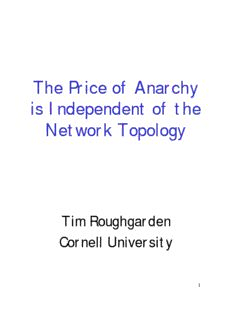
The Price of Anarchy is Independent of the Network Topology PDF
Preview The Price of Anarchy is Independent of the Network Topology
The Price of Anarchy is Independent of the Network Topology Tim Roughgarden Cornell University 1 Traffic in Congested Networks The Model: • A directed graph G = (V,E) • k source-destination pairs (s ,t ), …, (s ,t ) 1 1 k k • A rate r of traffic from s to t i i i • For each edge e, a latency fn l (•) [cts, nondecreasing, convex] e Example: (k,r=1) l(x)=x Flow = ½ s t 1 1 l(x)=1 Flow = ½ 2 Selfish Routing Traffic and Flows: • f = amount of traffic routed P on s -t path P i i • flow vector f routing of traffic s t Selfish routing: what flows arise as the routes chosen by many noncooperative agents? 3 Nash Flows Some assumptions: • agents are small relative to network • want to minimize personal latency Def: A flow is at Nash equilibrium (or is a Nash flow) if all flow is routed on min-latency paths Flow = 1 x x Flow = .5 s t s t 1 1 Flow = 0 Flow = .5 this flow is envious! Fact: [Beckmann et al. 56] Nash flows always exist 4 The Cost of a Flow Our objective function: • l (f) = sum of latencies of edges on P P (w.r.t. the flow f) • C(f) = cost or total latency of flow f: S f • l (f) P P P s t Key question: how good (or bad) are Nash flows? 5 The Inefficiency of Nash Flows Fact: Nash flows do not optimize total latency [Pigou 1920] (cid:222) lack of coordination leads to inefficiency x • Cost of Nash = 1 1 ½ s t • Cost of OPT = ¾ 1 0 ½ Def : price of anarchy = worst-case Nash/OPT ratio • also coordination ratio of [Koutsoupias/Papadimitriou 99] 6 Linear Latency Fns Def: a linear latency function is of the form l (x)=a x+b e e e Thm : [Roughgarden/Tardos 00] network w/linear latency fns (cid:222) cost of cost of = 4/3 × Nash flow opt flow Cor: price of anarchy realized in a two-link network! Point: worst-case Nash arises from overcongesting one of two available routes (and that’s all) 7 No Dependence on Network Topology Thm: for any class of latency fns including the constant fns, worst Nash/OPT ratio is in a two-link network. • inefficiency of Nash flows always has simple explanation • network topology plays no role Note: worst ratio may be (much) larger than 4/3 with nonlinear latency fns (modify Pigou’s ex) 8 Comparison to Previous Work Remark: networks of parallel links are not worst-case examples for: • Approximate Nash flows, integral Nash flows [Roughgarden/Tardos FOCS ‘00] • Stackelberg equilibria [Roughgarden STOC ‘01] • Braess’s paradox, maximum travel time obj fn [Roughgarden FOCS ‘01] 9 Characterizing OPT Def: f is at Nash equilibrium iff all flow travels along paths with minimum latency Latency: l (f ) e e Lemma: [BMW 56] f is optimal iff all flow travels along paths with minimum marginal cost Marginal cost: l (f ) + f •l ’(f ) e e e e e latency of new flow added latency for flow already on edge 10
Description: